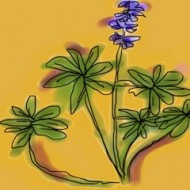The Dry Garden: Sheltering nests
Some of us are familiar with the concept of stilling the saws to allow birds to breed, but we follow an Eastern calendar. Unfortunately, that time frame doesn’t apply in Southern California. Whereas bird-nesting in the East is a spring event, it begins here in winter. Two of our most beloved local hummingbirds, Allen’s and Anna’s, started nesting in December and will be nesting throughout spring, says Kimball Garrett, collections manager for the ornithology department of the Natural History Museum of Los Angeles County. Click here to keep reading the Dry Garden column in the Los Angeles Times.…
The Dry Garden: ‘Canyon Prince’
OF ALL the creatures that disperse plants in nature, we humans may be the quirkiest. Take how we distribute New Zealand flax. We fight back its blades along what seems like every other front walk.
This column is to commend an indigenous alternative to New Zealand flax for the gardens of greater Los Angeles: a type of giant wild rye called Canyon Prince. Ninety-nine percent of the time that flax is used in California, this cultivar of Leymus condensatus could perform the same function, but better.
To keep reading the lastest installment of the Dry Garden in the Los Angeles Times, click here.…
The Dry Garden: Capturing the spirit of LA’s streams
Contemporary map of the Ballona Creek watershed with overlay of 1902 streams and wetlands. Source: "Seeking Streams" by Jessica Hall et al, 606 Studio, Cal Poly Pomona.
WHEN it snows in the mountains and rains in the basin, Jessica Hall thinks of the lost streams of Los Angeles. In fact, she thinks of them all the time. For the last nine years, the 41-year-old garden designer has been retracing the paths of the native creeks, streams and springs that once ran wild before they were filled in and paved for homes.
In the process, Hall has come to believe that the best town planning and landscape design principles for the future may lie in understanding the habits of the watercourses of the past.
Those who missed the profile of Hall last August by Times staff writer Hector Tobar have a treat in store reading about how Hall tracked down Sacatela …
The Dry Garden: ‘Sustainable Landscaping for Dummies’
The idea that suburban gardens might be “sustainable” came late to Southern California. Modern Los Angeles was sold on the promise that anything grows. Exotic plants were status symbols. Sunshine was constant, and the only worry about water was finding plants best suited to go next to the swimming pool. More than a century later, the fantasy style is out. Sustainable is in. There’s only one problem. What does sustainable mean?
Landscape architect Owen Dell has cut through the eco-babble to offer not just a definition, but also a how-to book. The Santa Barbara-based author of “Sustainable Landscaping for Dummies,” published by Wiley this year, begins by defining sustainability.
Click here to keep reading this week’s Dry Garden column in the Los Angeles Times.…
Permanent water conservation
California did it. This month, the Legislature passed a package of bills that includes a statewide urban water conservation goal of 20% by 2020. We have confronted the kind of conservation that will be needed to secure the water supply of Los Angeles, and the state, in the face of population growth and climate change. Or have we? It all depends on where you put the goal posts.
To keep reading today’s op-ed in the Los Angeles Times on permanent water conservation, click here.
Correction: In citing projected population growth by 2020 for Southern California in this article, I quoted predictions as high as 43%. That was incorrect. The correct figure for Southern California as forecast in 1998 by the California Department of Housing and Community Development is 13.8% and for state-wide growth 48.3%. I greatly regret the error. Please see the comment string for more discussion of the …
« go back — keep looking »

